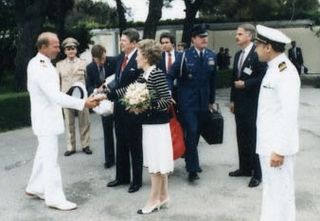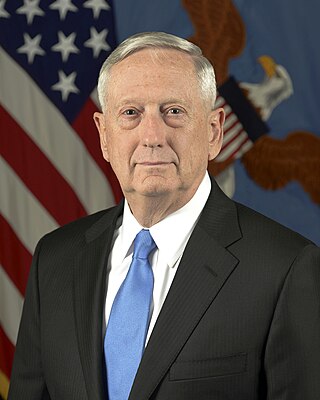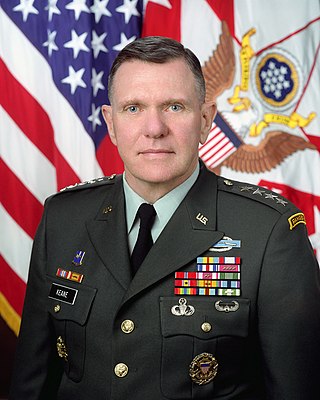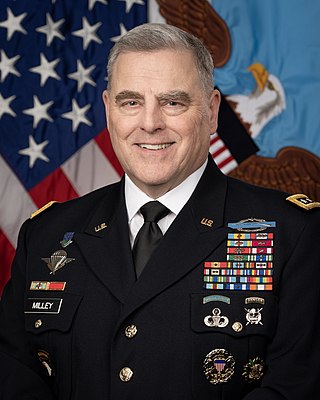
William James Perry is an American mathematician, engineer, businessman, and civil servant who was the United States Secretary of Defense from February 3, 1994, to January 23, 1997, under President Bill Clinton. He also served as Deputy Secretary of Defense (1993–1994) and Under Secretary of Defense for Research and Engineering (1977–1981).

John Philip Abizaid is a retired United States Army general and former United States Central Command (CENTCOM) commander who served as the United States Ambassador to Saudi Arabia from 2019 to 2021.

A commander-in-chief or supreme commander is the person who exercises supreme command and control over an armed force or a military branch. As a technical term, it refers to military competencies that reside in a country's executive leadership, a head of state, head of government, or other designated government official.

The defense readiness condition (DEFCON) is an alert state used by the United States Armed Forces. For security reasons, the US military does not announce a DEFCON level to the public.

The Goldwater–Nichols Department of Defense Reorganization Act of October 4, 1986 made the most sweeping changes to the United States Department of Defense since the department was established in the National Security Act of 1947 by reworking the command structure of the U.S. military. It increased the powers of the chairman of the Joint Chiefs of Staff and implemented some of the suggestions from the Packard Commission, commissioned by President Reagan in 1985. Among other changes, Goldwater–Nichols streamlined the military chain of command, which now runs from the president through the secretary of defense directly to combatant commanders, bypassing the service chiefs. The service chiefs were assigned to an advisory role to the president and the secretary of defense, and given the responsibility for training and equipping personnel for the unified combatant commands.

The Single Integrated Operational Plan (SIOP) was the United States' general plan for nuclear war from 1961 to 2003. The SIOP gave the President of the United States a range of targeting options, and described launch procedures and target sets against which nuclear weapons would be launched. The plan integrated the capabilities of the nuclear triad of strategic bombers, land-based intercontinental ballistic missiles (ICBM), and sea-based submarine-launched ballistic missiles (SLBM). The SIOP was a highly classified document, and was one of the most secret and sensitive issues in U.S. national security policy.

The nuclear football is a briefcase, the contents of which are to be used by the president of the United States to communicate and authorize a nuclear attack while away from fixed command centers, such as the White House Situation Room or the Presidential Emergency Operations Center. Functioning as a mobile hub in the strategic defense system of the United States, the football is carried by a military aide when the President is traveling.

James Norman Mattis is an American military veteran who served as the 26th United States secretary of defense from 2017 to 2019. A retired Marine Corps four-star general, he commanded forces in the Persian Gulf War, the War in Afghanistan, and the Iraq War.
A unified combatant command, also referred to as a combatant command (CCMD), is a joint military command of the United States Department of Defense that is composed of units from two or more service branches of the United States Armed Forces, and conducts broad and continuing missions. There are currently 11 unified combatant commands, and each is established as the highest echelon of military commands, in order to provide effective command and control of all U.S. military forces, regardless of branch of service, during peace or during war time. Unified combatant commands are organized either on a geographical basis or on a functional basis, e.g., special operations, force projection, transport, and cybersecurity. Currently, seven combatant commands are designated as geographical, and four are designated as functional. Unified combatant commands are "joint" commands and have specific badges denoting their affiliation.

The National Command Authority (NCA) is an independent federal agency of the Government of Pakistan that is responsible for safeguarding of the national security through the military applications of the nuclear science.

A nuclear briefcase is a specially outfitted briefcase used to authorize the use of nuclear weapons and is usually kept near the leader of a nuclear weapons state at all times.

The United States Department of Defense is an executive branch department of the federal government of the United States charged with coordinating and supervising all agencies and functions of the U.S. government directly related to national security and the United States Armed Forces. As of June 2022, the U.S. Department of Defense is the largest employer in the world, with over 1.34 million active-duty service members, including soldiers, marines, sailors, airmen, and guardians. The Department of Defense also maintains over 778,000 National Guard and reservists, and over 747,000 civilians bringing the total to over 2.87 million employees. Headquartered at the Pentagon in Arlington County, Virginia, just outside Washington, D.C., the Department of Defense's stated mission is to provide "the military forces needed to deter war and ensure our nation's security".

John M. "Jack" Keane is a former American general who served as vice chief of staff of the United States Army from 1999 to 2003. He is a national security analyst, primarily on Fox News, and serves as chairman of the Institute for the Study of War and as chairman of AM General.
The Gold Code is the launch code for nuclear weapons provided to the President of the United States in their role as commander-in-chief of the armed forces. In conjunction with the nuclear football, the Gold Codes allow the president to authorize a nuclear attack. Gold Codes, as well as a separate nuclear football, are also assigned to the vice president in case the president is incapacitated or otherwise unable to discharge the duties of office pursuant to the Twenty-fifth Amendment to the United States Constitution. Gold Codes are arranged in a column and printed on a plastic card nicknamed "the biscuit".

Charles Quinton Brown Jr. is a United States Air Force general who has served as the 21st chairman of the Joint Chiefs of Staff since October 1, 2023. Prior to his appointment, Brown served as the 22nd chief of staff of the Air Force from 2020 to 2023. Brown entered the Air Force in 1984 and served as a fighter pilot, where he has logged over 3,000 flight hours, including 130 hours in combat. He has commanded the Pacific Air Forces, U.S. Air Forces Central Command, 31st Fighter Wing, 8th Fighter Wing, U.S. Air Force Weapons School, and 78th Fighter Squadron. He has also served as deputy commander of the U.S. Central Command.
Nuclear command and control (NC2) is the command and control of nuclear weapons. The U. S. military's Nuclear Matters Handbook 2015 defined it as the "activities, processes, and procedures performed by appropriate military commanders and support personnel that, through the chain of command, allow for senior-level decisions on nuclear weapons employment." The current Nuclear Matters Handbook 2020 [Revised] defines it as "the exercise of authority and direction, through established command lines, over nuclear weapon operations by the President as the chief executive and head of state."

Mark Alexander Milley is a retired United States Army general who last served as the 20th chairman of the Joint Chiefs of Staff from October 1, 2019, to September 30, 2023. He previously served as the 39th chief of staff of the Army from August 14, 2015, to August 9, 2019, and held multiple command and staff positions in eight divisions and special forces throughout his military career.

Paul Joseph Selva is a retired United States Air Force general who served as the tenth vice chairman of the Joint Chiefs of Staff. In this capacity, he was the nation's second-highest-ranking military officer, and the highest-ranking officer in the Air Force. He assumed his last assignment on July 31, 2015, and retired on August 1, 2019. Selva is a command pilot with more than 3,100 hours in the C-5, C-17A, C-141B, C-37, KC-10, KC-135A and T-37.

John Earl Hyten is a retired United States Air Force general who served as the 11th vice chairman of the Joint Chiefs of Staff from 2019 to 2021. A career space operations and acquisitions officer, he commanded the United States Strategic Command from 2016 to 2019 and the Air Force Space Command from 2014 to 2016.